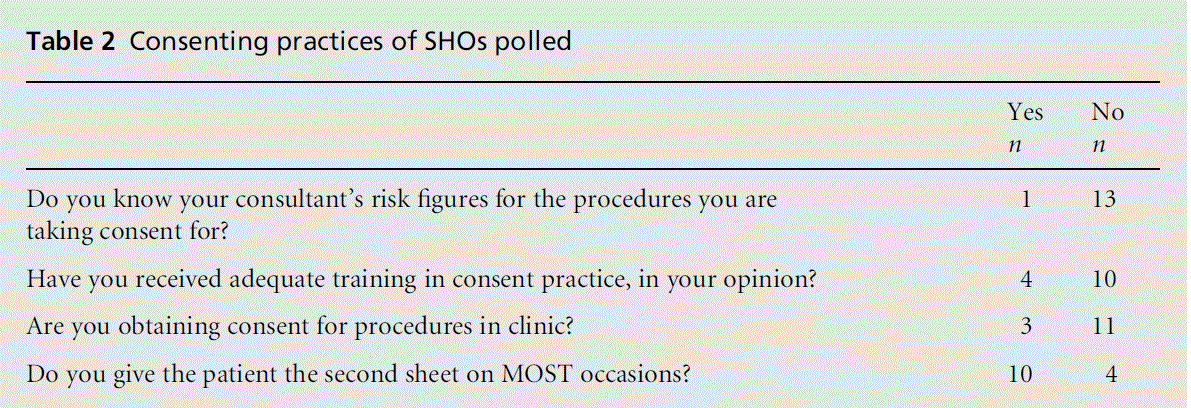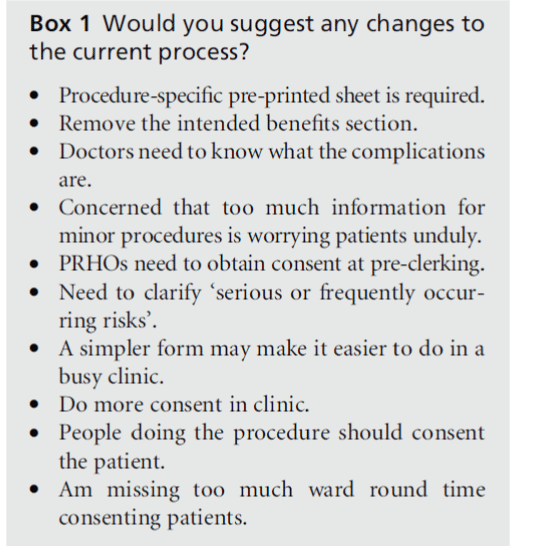Research Paper - (2004) Volume 12, Issue 2
Specialist Registrar in General Surgery, Department of Surgery, Glenfield General Hospital, Leicester, UK
Abigail Millett MB ChB
Pre-registration House Officer
Giuseppe Garcea MRCS
Specialist Registrar in General Surgery
Christopher Sutton FRCS
Specialist Registrar in General Surgery
Ashley Dennison FRCS
Consultant Hepatobiliary Surgeon
Department of Surgery, Leicester General Hospital, Leicester, UK
Received date: 30 September 2003; Accepted date: 13 January 2004
Introduction Informed consent has been gaining increased importance in the medical profession over recent years. To ensure good practice the government and General Medical Council (GMC) have published new guidelines including a consent form.A recent survey in our trust demonstrated that over50% of the consent for general surgical cases was performed by senior house officers (SHOs). We undertook a telephone survey of all the SHOs on the general surgical on-call rota at the three hospitals within the trust, to ascertain the level of knowledge and consenting practice. We also asked what they would record for serious or frequently occurring risks for seven general surgical procedures on the consent form.Results Fourteen SHOs were questioned, only five had read the GMC guidelines on consent and three the government document. Four claimed they had training on the consent procedure and only one could quote the risk figures for their consultant. The majority were missing much of the morning ward round consenting cases. There was some confusion on what constitutes patient risk when consenting, and of the seven procedures the majority of consent would fall below acceptable practice in discussingpotential risks. Conclusion This survey has highlighted that procedure-specific consent forms are necessary and that training for SHOs in consent needsto be more rigorous. Procedure-specific consent forms would also aid the consent process and ensure a more uniform process. Mechanisms may also need to be put in place to fit this additional role on to a grade that already has many commitments within the firm.
consent, guidelines, patient risk, surgical trainees
Informed consent has been a hotly debated topic for many years. Recently, the government and the General Medical Council (GMC) have set about clarifying the procedures involved by publishing new guidelines.[1,2]
They have also introduced a new form that allows the insertion of ‘serious and frequently occurring risks’, a second sheet for the patient, and expressed the desire that consent should take place before planned admission with a confirmatory signature prior to surgery.
A recent audit (submitted) in our hospital showed that over 50% of the consents were being obtained by senior house officers (SHOs). It has been the policy of this trust for almost two years that pre-registration house officers (PRHOs) should not be carrying out consent. The changing role of the basic surgical trainee, especially in this trust, has meant that they have had to adapt to this additional task. In light of these new guidelines we present a telephone questionnaire of all the SHOs on the general surgical on-call rota within the trust. The questionnaire was designed to find out their level of understanding about consent, and their practices.
A telephone questionnaire was conducted in early December 2002 with all of the SHOs involved in general surgical on-call rotas at the three hospitals within a teaching hospital trust. It was recorded whether they had read the GMC booklet on consent or were aware of the government document, and enquiries were made as to how their particular firm conducted consent, i.e. in clinic, or on the day of surgery. Additional information recorded included when the consent was carried out and the time missed from morning ward rounds consenting patients, knowledge of particular risk figures for their consultants, whether the SHOs had had any training and the potential complications they would tell patients undergoing seven general surgical operations about (laparoscopic and open appendicectomy, laparoscopic cholecystectomy, inguinal hernia repair, haemorrhoidectomy, right A telephone questionnaire was conducted in early December 2002 with all of the SHOs involved in general surgical on-call rotas at the three hospitals within a teaching hospital trust. It was recorded whether they had read the GMC booklet on consent or were aware of the government document, and enquiries were made as to how their particular firm conducted consent, i.e. in clinic, or on the day of surgery. Additional information recorded included when the consent was carried out and the time missed from morning ward rounds consenting patients, knowledge of particular risk figures for their consultants, whether the SHOs had had any training and the potential complications they would tell patients undergoing seven general surgical operations about (laparoscopic and open appendicectomy, laparoscopic cholecystectomy, inguinal hernia repair, haemorrhoidectomy, right
Fourteen SHOs were contacted covering breast, upper gastrointestinal (GI), paediatric, colorectal and vascular firms, the total number within the trust. For six, this was their first post in general surgery, seven were commencing their second placement in general surgery and one SHO their third. All apart from two SHOs were in their second year of SHO training. Only five (36%) had read the GMC booklet on consent and three (21%) the 12 key points from the government document. The percentage of the firm’s consent undertaken by the basic surgical trainees varied from 20% to almost 100% (see Table 1). A considerable proportion of morning ward round time was missed by the SHOs whilst obtaining consent from patients (see Table 1). Two of the SHOs attended the firm’s preclerking clinic to obtain consent and a further three (21%) would see patients prior to the morning round. Only three (21%) were obtaining consent from patients in clinic and seven (50%) were regularly asking patients to sign the confirmation of consent section of the form, if consent had already been obtained in the outpatient clinic (see Table 2).
Some confusion exists on what is understood by a ‘serious or frequently occurring risk’ when obtaining consent from patients. One stated that they would warn of a complication that occurred 1 in 1000 times, three on 1 in 100 occasions and the remaining 10 were unsure. Figures 1–7 illustrate this general uncertainty by showing considerable variation in what SHOs say they would inform patients of,when discussing risk, in seven general surgical procedures. Of particular note is the poor notification of the possibility of chronic pain following inguinal hernia repair, stoma formation and anastomotic leaks in anterior resections, incontinence following haemorrhoidectomy and bile duct injury and leaks following laparoscopic cholecystectomy.
When directly questioned most of the SHOs (see Table 2) felt that they were not adequately trained in the consent process and only one was aware of their consultant’s risk figures for the procedures they obtained consent for. Most of the SHOs were giving the patient the second sheet on the majority of occasions (see Table 2). When asked if they could suggest any changes to the current consent process only two stated they were happy with the situation while the others suggested a variety of reasons for their dissatisfaction, summarised in Box 1.



The consent process is now under scrutiny as surgery is practised in an increasingly litigious society. Our survey, although of a small number of doctors’ opinions, illustrates that across one teaching hospital trust of three hospitals serving approximately one million people, there is a marked variation in practice. The fact that PRHOs do not take consent in our trust has meant further work demands on the SHO to complete this task. The survey has shown that over half of the consent is undertaken by the SHOs and hence review of their practice is essential to ensure patients are receiving adequate informed consent.
New guidelines have been issued recently and every practising doctor has been mailed a copy of the good practice booklets from the GMC including Seeking patients’ consent; the ethical considerations.[1,2] Of some concern is that only a third of the doctors polled had actually read this despite carrying out consent on a daily basis, and all except one admitted they felt that they were not adequately trained. This echoes concerns raised about the level of understanding of what is legal and informed consent. A poll of 120 doctors in Nottingham found that the consenting doctor’s lack of knowledge of the procedure and its risks was in many cases below whatwould be deemed necessary for obtaining ‘informed consent’.[3] A study by Skene and Millwood reached similar conclusions from a poll of 950 doctors in Australia.[4] Soin et al in 1993 demonstrated this lack of knowledge by polling staff at a hospital on 24-hour and 30-day mortalities for patients undergoing five common general surgical procedures.[5] They found that the more senior the staff, the more accurate the estimates, although even senior surgical staff could be markedly inaccurate with three out of five registrars polled stating a 30-day mortality for hernia repair of 1%!
Some of the responsibility falls onto the individual doctor to ensure that he/she is delivering the best possible practice, butwider educational concerns need to be addressed at local and national level. The study has illustrated that there is confusion as to what constitutes a ‘serious and frequently occurring risk’. The current definition is ‘a significant risk which would affect the judgement of a reasonable patient’ although reasonable is difficult to translate into practice.[6] Although guidance from seniors would provide additional education it is the profession itself that needs to agree what the standards of consent should be. Agreement on the risks posed by each procedure and incorporated within procedure-specific consent forms would reduce this ambiguity. Appropriate spaces could be left to insert additional risks and the consultant’s individual figures, to avoid a totally prescriptive consent.
In our trust, variation across the firms and hospitals on when consent is carried out is considerable. Many SHOs are missing ward rounds to obtain consent from patients the morning prior to surgery, with only two managing to consent patients at pre-clerking. There is probably some bias in this result, as many of the patients would have been added to the waiting lists prior to the forms being introduced, and as more consent is anecdotally being carried out in clinic this number should reduce. The ideal time would be to do this during pre-clerking, but with other commitments this is difficult for most SHOs.
Although a small number of doctors are represented, this is a poll of all SHOs undertaking consent in general surgery serving a large population. The current situation is variable within a single trust and innovative solutions are required to attempt to standardise the process and avoid potential litigation. The study has highlighted that despite new forms and guidelines, trainees in our trust have poor knowledge regarding risk and consent, a situation which probably also exists nationally. It is anticipated that highlighting this potential problem may stimulate debate on how best to achieve informed consent, who should obtain it, when and by what means, and to consider more carefully the consenting of patients to ensure good practice.
• The level of understanding of consent is generally poor at the SHO grade.
• There is a general underestimation of its importance.
• Guidance and education are required to improve the consent process.
• Confusion exists as to the definition of ‘serious and frequently occurring risks’.
• Professionally agreed national procedure-specific consent forms may be part of the solution.
• Local consideration of when consent is undertaken is necessary, not only to benefit the patient but also to utilise SHO time and training efficiently.